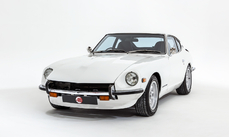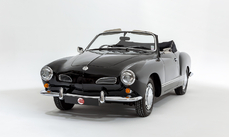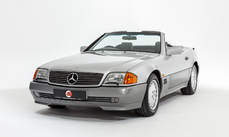Mitsubishi Lancer Evo III GSR 1995
Allmän beskrivning :
Model History
Flush with success from its Galant VR-4 and hungry for WRC victory, Mitsubishi determined in 1990 that further success would require a new platform. To that end, Mitsubishi engineers started with VR-4’s proven drivetrain and shoehorned it into the lighter, smaller Lancer chassis.
The Evolution I was introduced in 1992 to compete in the World Rally Championship. It used the 2-litre turbocharged DOHC engine and 4WD drivetrain from the original Galant VR-4 in a Lancer chassis, and was sold in GSR and RS models. The latter was a stripped-down club racing version that lacked power windows, anti-lock brakes, a rear wiper, and had steel wheels to save approximately 70 kg less than the 1238 kg GSR, while the former came with all of the conveniences of a typical street car. It came with Mitsubishi’s 4G63 engine producing 244hp at 6,000 rpm and 228 ft lb at 3,000 rpm, along with all-wheel drive, which would become a trademark on all Evo models.
Mitsubishi’s intention was to improve power output with each Evolution, and the Evo II started the trend. But with speeds on tarmac stages getting higher, reducing lift and improving cooling performance became the priority for the Evo III. A larger rear wing, front airdam with brake cooling vents, and rocker panel extensions were fitted and, of course, power was up again.
The Evo III arrived in January 1995 looking a lot more serious than its predecessor. It sported a new front end (to channel air better to the radiator, intercooler, and brakes), new side skirts and rear corners, and the rear wing had grown drastically to reduce lift. Under the vented aluminium bonnet a new TDO5-16G6-7 Turbo, new exhaust system, and increased compression brought another 10hp rise over the Evo II, although torque output was unaltered aside from a higher final drive ratio. Both GSR and RS versions still used the same five-speed gearbox. Interior tweaks were limited to a new Momo steering wheel and new fabric on the Recaro seats.
Equipment
Recaro SRD front seats, Digital climate control air conditioning, Electric windows front and rear, Electrically adjustable and folding door mirrors, Mitsubishi cassette radio, Diatone/Mitsubishi speaker system, Electric aerial, Leather Momo steering wheel, Leather gear knob, Rear wiper, GSR bodykit with colour-matched door handles and mirror covers, Front and rear strut braces, Cusco coil-over suspension, Remote central locking with spare key, Space saver spare wheel, Wheel brace, Jack, Original Mitsubishi document pack and service booklet, Original Evo III sales brochure, BIMTA mileage verification certificate.
Exterior
This handsome little Evo looks great in its original paint scheme of Queens Silver with OZ alloys in white. The panels are nice and straight along both sides and while the body is not 100% blemish-free the car still presents to a great standard overall. The paint retains a glossy finish throughout, the lights are crystal clear, and the decals at the rear look new. Better still, having resided on the salt-free roads of Japan until 2018, this example is lovely and solid underneath with no rust issues. Upon arrival into the UK the car was treated to a bespoke stainless exhaust system with OEM-style dual exhaust tips – a rare sight on any Evo!
Interior
The factory finish continues inside. The cabin is well appointed with fully operational digital climate control AC, electrically adjustable and folding door mirrors, front and rear electric windows, the original cassette radio and of course those high-back Recaro front seats. Free from any unsightly modifications or “upgrades” the interior space remains just as it did leaving the factory. There are no holes in the dash from aftermarket gauges and the seats show almost no wear to the deep bolsters. In the foot wells you’ll still find the original set of Lancer carpet mats with only the driver’s heel pad a little worn.
ENGINE & TRANSMISSION
Under the bonnet there are no engine mods to be found – even the factory blow-off valve is still fitted. The turbocharged 2-litre 4G63 engine has recently been serviced and had the timing belt replaced. The Evo has now driven a fully documented 75k miles from new. The Japanese maintenance history is all Mitsubishi, and a service at Mitsubishi was carried out upon arrival into the UK about 1,300 miles ago. The timing belt was replaced shortly after.
WHEELS, TYRES & BRAKES
The Evo III’s arches are filled perfectly with the factory 15-inch five-spoke OZ alloys. Having never needed refurbishment they all present in their original coat of white with the correct red decals and centre badges. The wheels are shod in a recently fitted matching set of Toyo Proxes 205/60 R15 tyres with less than 500 miles of wear.
History File
With a total of just 7,000 Evo IIIs produced between January 1995 and August 1996, low mileage and original examples such as this rarely come up for sale. This car was first registered in February ’95. The low mileage of just 75k is fully verified by a comprehensive Mitsubishi service record, as detailed in the original document pack (and listed below). A BIMTA Certificate of Mileage Verification also accompanies the car.
08/02/1998 at 25,120km / 15,609 miles – Saitama Mitsubishi20/02/2000 at 38,888km / 24,164 miles – Saitama Mitsubishi26/02/2002 at 51,728km / 32,142 miles – Saitama Mitsubishi21/02/2004 at 66,696km / 41,443 miles – Saitama Mitsubishi15/07/2006 at 79,443km / 49,364 miles – Saitama Mitsubishi10/02/2008 at 92,069km / 57,209 miles – Kanto Mitsubishi27/02/2010 at 104,998km / 65,243 miles – Kanto Mitsubishi03/03/2012 at 109,419km / 67,990 miles – Kanto Mitsubishi24/02/2014 at 111,922km / 69,545 miles – Kanto Mitsubishi04/10/2015 at 114,173km / 70,944 miles – Kanto Mitsubishi11/09/2016 at 115,787km / 71,947 miles – Kanto Mitsubishi06/03/2017 at 116,800km / 72,576 miles – Kanto Mitsubishi29/09/2017 at 118,373km / 73,554 miles – Kanto Mitsubishi11/04/2018 at 118,974km / 73,927 miles – Farnham Mitsubishi
Since arriving in the UK the Evo has been treated to a new stainless steel exhaust system, a service at Mitsubishi and a timing belt change. The car is fully UK-registered and the MOT is valid until May 2020. Given its low mileage, provenance and originality this car represents an excellent investment opportunity for the collector or like-minded enthusiast.
http://www.4starclassics.com/for-sale/mitsubishi-lancer-evo-iii-gsr-for-sale/
1995 Mitsubishi Lancer Evo III GSR is listed såld on ClassicDigest in Kingsley by 4 Star Classics for £12995.
Fakta i bilen
Karosstyp : Personbil Märke : Mitsubishi Modell : Lancer Modellversion : Evo III GSR Motorvolym : 2.0 Årsmodell : 1995 Karosstyp : Race/Rally Car Läge : Hampshire
Såld
Information om säljaren
Såld
People who viewed this Mitsubishi Lancer also viewed similar Mitsubishi listed at ClassicDigest
Other cars listed for sale by this dealer
om Mitsubishi
Mitsubishi: En Resa Genom Historien (fram till 1980-talet)1. Tidiga Ursprung:
Grundande: Mitsubishis rötter sträcker sig till grundandet av ett rederi av Yataro Iwasaki år 1870.
Diversifiering: Företaget utvidgade till kolgruvdrift, skeppsbyggnad och andra branscher, vilket lade grunden för Mitsubishi Group.
2. De Första Fordonsförsöken:
Inledande Biltillverkning: Mitsubishi vågade sig in i biltillverkning i början av 1900-talet.
Modell-A: År 1917 introducerade Mitsubishi sin första serieproducerade bil, Modell-A, Japans första serieproducerade bil.
3. Efterkrigstiden:
Omstrukturering: Efter andra världskriget mötte Mitsubishi utmaningar men genomgick omstrukturering och återupptog bilproduktionen.
Jeep-Produktion: Fokuserade initialt på att producera jeepar och bidrog betydande till Japans bilindustris återhämtning.
4. Milstolpsmodeller:
Mitsubishi 500: Introducerades 1960 och var en kompakt bil som spelade en roll för att popularisera mindre fordon i Japan.
Mitsubishi Colt 600: Släpptes 1962 och var en småbil som bidrog till Mitsubishis expansion på bilmarknaden.
5. Global Expansion och 1970-talet:
Partnerskap: Mitsubishi skapade partnerskap med internationella biltillverkare och expanderade därmed utanför Japan.
Galant och Lancer: Modeller som Galant och Lancer blev populära under 1970-talet och visade Mitsubishis engagemang för innovation och prestanda.
6. Teknologiska Framsteg:
Mitsubishi Astron-motor: Introducerades på 1970-talet och blev en standard i Mitsubishis fordon, känd för sin hållbarhet och effektivitet.
7. 1980-talets Höjdpunkt:
Mitsubishi Pajero: Lanserades i början av 1980-talet och markerade Mitsubishis inträde på SUV-marknaden, blev en global framgång.
Starion: Starion, introducerad mitten av 1980-talet, var en sportbil som visade Mitsubishis prestandakapacitet.
8. Klassiska Modeller från 1980-talet:
Mitsubishi Delica: Delica, först introducerad på 1960-talet men populär på 1980-talet, var en mångsidig van med olika konfigurationer.
Mitsubishi Mighty Max: Denna kompakta pickup var känd för sin hållbarhet och praktikalitet.
Mitsubishi Mirage: Mirage, tillgänglig som hatchback och sedan, blev populär för bränsleeffektivitet och pålitlighet.
Mitsubishis resa genom 1980-talet speglar dess utveckling från en mångfaldig koncern till en framstående aktör i den globala bilindustrin. Det var ett årtionde som introducerade ikoniska modeller och stärkte Mitsubishis rykte för innovation och prestanda.







